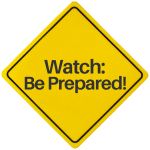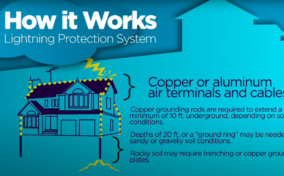Lightning is the most dangerous and frequently encountered weather hazard that most people experience each year. Lightning is caused by a discharge of atmospheric electricity from one cloud to another or from a cloud to the earth. Lightning can travel 90,000 miles per second and a lightning bolt can generate heat in excess of 50,000 degrees Fahrenheit—a temperature five times hotter than the surface of the sun.
See how to determine your risk, prepare your family, learn about your building code, and identify ways to strengthen your home against lightning.
Before lightning strikes, consider strengthening your home with a lightning protection system and surge protection devices to protect your home from lightning damage.
During the storm, stay safe by staying indoors and keeping away from windows and doors. Monitor the status of the storm and wait until it’s over to bathe, shower, wash dishes, or come into contact with water.
If you are away from your home, find a safe, enclosed shelter when you hear thunder or see lightning.
Wait at least 30 minutes after the last lightning strike or thunderclap to resume any outdoor activities.
If your house may have been struck by lightning, look for signs of fire: smoke, charred electrical outlets, or heat from your attic.
Please enter a more specific address.

A Severe Thunderstorm Watch is issued when severe thunderstorms are possible in and near the watch area. It does not mean that they will occur. It only means they are possible. NO PLACE outside is safe when thunderstorms are in the area.

A Severe Thunderstorm Warning is issued when severe thunderstorms are occurring or imminent in the warning area. If you hear thunder, immediately move to a safe shelter, a substantial building with electricity or plumbing, or an enclosed, metal-topped vehicle with windows up. Stay in the shelter for at least 30 minutes after you hear the last sound of thunder.
The Federal Alliance for Safe Homes (FLASH) — a 501(c)(3) nonprofit organization — is the leading consumer advocate for strengthening homes and safeguarding families from natural and manmade disasters.
The Playbook provides proven strategies for all leaders who wish to drive resilience.
This annual conference brings together the nation’s leading voices in disaster safety.
Inspect2Protect will help you understand the building code where you live.


Lightning Protection Systems
A cloud flash is lightning that occurs within a thundercloud that is not visible from the ground. Unlike cloud-to-ground lightning, which is visible and strikes the ground, cloud flashes occur within the cloud itself and are hidden by the dense layer of clouds.
Thunder is a sound wave created by the rapid expansion of air that occurs when lightning heats the air to extremely high temperatures. The intense heat causes the air to expand rapidly, creating a shock wave that travels through the atmosphere as sound waves, which we hear as thunder.
While you may not always see lightning when you hear thunder, it is not possible to have thunder without it.
Likewise, lightning always creates thunder. If you see lightning and do not hear thunder, it is likely you are too far away from the strike.